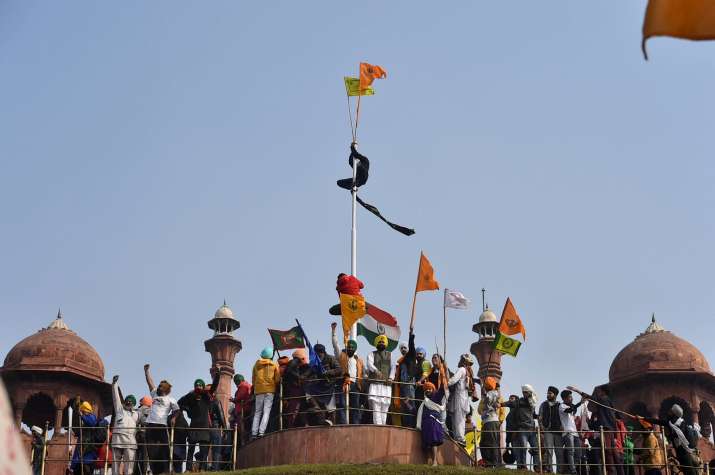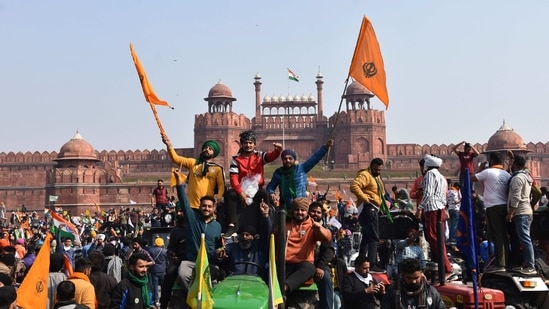What is Nishan Sahib, The Flag Hoisted by Protesting Farmers at Red Fort?
 ]
]
New Delhi: Dramatic scenes were witnessed on Tuesday, as thousands of protesting farmers swarmed the Red Fort and hoisted flags on the lower ramparts of the historic landmark. Protesters who entered the Red Fort also put up a saffron-coloured flag on a pole inside the premises of the iconic monument in the national capital. Also Read - Who is Lakha Sidhana, Gangster-turned-Activist Named in Delhi’s Tractor Rally Violence?
Soon after, social media was abuzz that a Khalistani flag was hoisted by the protesting farmers, triggering anger and outrage. Some claimed the national flag was taken off and farmers hoisted their flag in place of the Tricolour.
However, it was soon made clear that the flag was a Sikh Flag that is found in every Gurdwara and the same is carried invariably during religious processions. Also, the main Tricolour at the topmost pole at Red Fort remained untouched, contrary to several social media claims.
What is the ‘Nishan Sahib’?
The flag waved by the protesters is called “Nishan Sahib”, a triangular flag that represents Sikhism, and is sacred to Sikhs.
The emblem on the flag comprises of ‘Khanda’, a two-edged sword, Chakra, a disc, and two Kirpans that cross each other at the handles. This emblem was introduced during Guru Gobind Singh’s time and the Sikh community believe the Khanda to be a powerful tool that can differentiate truth from falsehood. It has also been said that Guru Gobind Singh used the Khanda to prepare amrit (holy nectar) by stirring it in sweetened water.
Apart from Gurdwaras, the flag is usually carried atop vehicles when people go for religious processions or even for religio-political gatherings, or during any movement.
All you need to know about Nishan Sahib, the flag hoisted by farmers on Red Fort
 ]
]
Farmers’ tractor march on Tuesday took an unexpected turn when a group of agitators entered the Red Fort and unfurled a religious flag ‘Nishan Sahib’ on the monument causing a major stir. Many farmers leaders and unions have disassociated themselves from the turn of events that took place on the 72nd Republic Day of India. Actor Deep Sidhu has been accused of instigating the farmers for the deviation in the route as well as for hoisting the flag over the Mughal monument that drew flak from politicians across all parties.
Regarding the flag that they hoisted, fake news spread like wildfire that the flag was a ‘Khalistani flag’, which is associated with separatists’ demand of Khalistan.
Amid all the chaos, what is Nishan Sahib?
-
The triangular saffron coloured flag furling outside a Gurdwara on a steel pole covered with saffron-colored cloth is most popularly associated with Guru Hargobind.
-
The flag also has an insignia called Khanda in the middle. The Khanda includes two swords and a chakra. The two swords are considered to represent miri-piri.
-
The flag and the insignia have appeared to have undergone various changes under Guru Hargobind. The Guru’s standard was saffron, ‘a colour perhaps borrowed from the Rajputs and one that became identified with self-sacrifice and martyrdom, particularly in the Khalsa panth,’ as per the Oxford Handbook of Sikh Studies.
Also Read | ‘Dirty conspiracy’: Farmers’ leaders accuse Centre of ‘sabotaging’ peaceful stir
-
Miri-piri resembles the relation of Akal Takht with the Harmandir. Akal Takht was developed under the supervision of Guru Hargobind. In the early seventeenth century, the Akal Takht was the site where the Guru and his courtiers would meet to discuss issues of justice as well as strategic response to the Mughals. “The Akal Takht was the locus of miri (temporal authority); the Harmandir the epicentre of piri (spiritual authority)”. The flag hence resembled the authority of the Guru and marked the place of dharamshala/Gurudwara.
-
While the flag has undergone significant changes through the Sikh history, the essential ‘Ik Onkar’, the opening of ‘Mul Mantar’, declaring the unity of the Eternal Guru remained intact.
-
The nishan sahib transformed into the symbol of sikh sovereignty and identity. The religious flag underwent more changes in the nineteenth century as the flag started resonating the Khalsa slogan degh, tegh and fateh (cooking pot, sword and victory.)
-
The nishan sahib often commands the respect and reverence of the Sikhs as the marker of gurudwara, “the sign which leads them towards the Darbar of the historical Gurus and of the Eternal Guru’ in which truth, justice, and sovereignty have been established”.
(Inputs from Oxford handbook of Sikh Studies by Pashaura Singh and Louis E. Fenech)
What is Nishan Sahib? It’s found flying atop every gurdwara
 ]
]
Was a Khalistani flag hoisted at Red Fort? No, it was a Sikh flag which is found in every gurdwara and people carry it almost invariably during religious processions. In gurdwaras , it is hoisted at a height with a ‘khanda’ (a doubleedged sword). The flag flies at the top of this and is called Nishan Sahib.
The type of flag that was fixed atop the pole in Red Fort is usually carried atop vehicles when people go for religious processions or even for religio-political gatherings, or during any movement.
Sikh flag in the Indian Army
Nishan Sahib aka the ‘Sikh flag’ is there at every gurdwara of the Sikh Regiment. When the contingents of the regiment move their gurdwara, they also carry the Sikh Flag along the ‘bir’ of Guru Granth Sahib and it is treated with great respect by officers and jawans. Nishan Sahib is found at every gurdwara in any Army cantonment.
The war cry of Sikh Regiment and Sikh Light Infantry is the Sikh war cry, ‘Bole So Nihal, Sat Sri Akal’. Motto of the Sikh Regiment is ‘Nischay Kar Apni Jeet Karoon (With determination, I will be triumphant) which is taken from a hymn by Guru Gobind Singh. The regimental motto of the Sikh Light Infantry is ‘Deg Teg Fateh (prosperity in peace, victory in war)’. Protesters also raised the slogans of ‘Bole So Nihal Sat Sri Akal’ throughout the tractor march and also at the Red Fort.
Was the Tricolour removed at Red Fort?
No, the videos of the incident make it abundantly clear the ‘Sikh flag’ was mounted on an empty pole and no one touched the Tricolour. Some protesters were even carrying Tricolours along with Sikh flags and flags of the farmers’ unions.